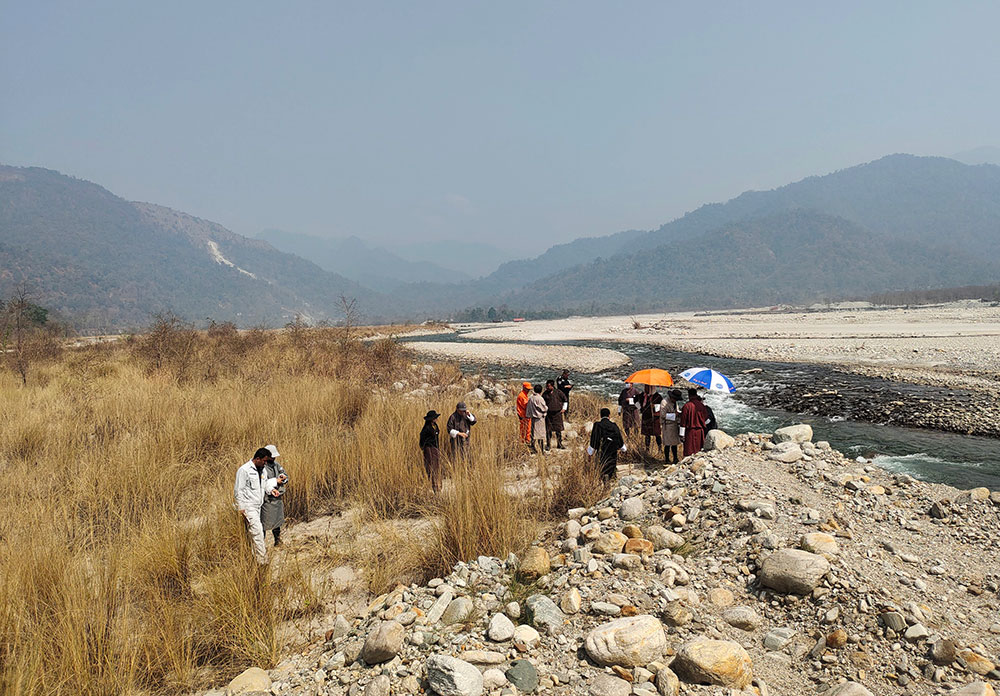Lhakpa Quendren
Gelephu—With temperatures in Gelephu already hitting 28°C, signalling the onset of the monsoon season, the settlements along the riverbanks live in fear.
For instance, the Shetikhari stream remains a threat. This stream, which usually dries up completely after the monsoon, flooded three times last monsoon. There is a lack of permanent flood mitigation measures.
Implementing permanent prevention measures could cost the government a huge amount, as other streams in Sarpang also swell during the rainy season and pose a threat to nearby settlements and roads.
Despite these shortfalls, the Sarpang Dzongkhag Administration’s disaster management committee conducted a comprehensive inspection along the riverbanks of Maochhu and Shetikhari in Gelephu on March 11.
This annual readiness aims to reduce the potential risks associated with the monsoon season.

Disaster management committee on assessment tour along the river banks in Gelephu
Sarpang dzongdag, Lobzang Dorji, said that potential risk areas have been identified and stakeholders alerted to implement protective measures. “We will need to implement the necessary interventions within the next two to three months.”
He added that both the surface collectors and relevant stakeholders should take responsibility and be held accountable for any issue arising from their activities.
Three surface collectors operate along the riverbanks of Maochhu and Shetikhari, extracting riverbed materials. Sarpang has about seven dredging sites.
The Natural Resources Development Corporation Limited has been engaged in surface collection from the riverbed at the Maochhu site, covering an area of 270 acres. And a private construction firm has been awarded a three-year contract for riverbed material collection and dredging at the Shetikhari stream.
It has been observed that about 60 percent of the riverbed materials and dredging collected from the surface align with guidelines. However, activities conducted beyond the identified area at Shetikhari have been cautioned and advised to implement interventions before the onset of the monsoon.
The companies authorised to conduct dredging activities are required to initiate mitigation efforts according to the guidelines and contract agreement.
The dzongda said that a comprehensive investigation is required to prioritise and implement sustainable measures aligned with the budgets and plans.
He added that long-term solutions should consider understanding the characteristics of the rivers, among other factors.
“With many streams flowing towards the southern plains, the river courses have been diverting in different directions during the monsoon every year. This poses a threat to the immediate settlements, private lands, and other infrastructures on both sides of the riverbanks,” he added.
The government of the Netherlands will implement erosion and flood protection walls on both sides of the Shetikhari stream, covering a 2km stretch starting from the confluence at the Maochhu and extending upstream through the Pelrithang village.
Every year, the Gelephu Gewog Administration spends about Nu 4 to 5 million on activities related to flood prevention measures for the Shetikhari stream.
Gelephu Gup Prem Prasad Katel said that the project for permanent measures is expected to be implemented in September after the monsoon season subsides. “This is expected to relieve nearby settlements by preventing further land loss and damage.”
“We have been relying on temporary measures until now, only to see them swept away all at once during the monsoon. It feels like we have squandered resources on these temporary interventions,” he added.


